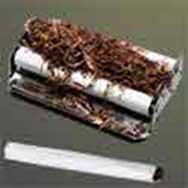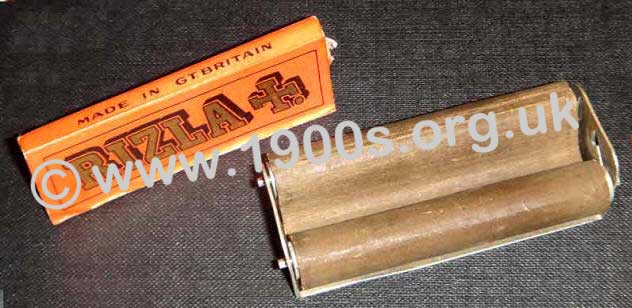Rolling your own cigarettes, early-to-mid 20th Century

As taxes on tobacco progressively increased from the 1950s, smokers tried to economise by moving to making their own cigarettes, known as roll-ups, from cigarette papers and tobacco. This page describes how it was done and how smokers reacted to it.
____
By the webmaster, based childhood observations in the 1950s, firsthand contributions and additional research
'Roll ups' cigarettes
In view of the shortages and austerity during the Second World War and the years afterwards, my father repeatedly tried making his own cigarettes from cigarette papers and tobacco, both bought from the local tobacconist. These cigarettes were known as 'roll-ups'.
Tobacco from used cigarette stubs
contributed by Desmond Dyer, lifetime smoker
We made our own 'roll ups' from stubs in ashtrays around the house when desperate for tobacco and money was short. A joke at the time in men's urinals was "Please do not discard your cigarette butts in the urinal as this makes them nearly unsmokeable".
Cigarette papers
The cigarette papers were made by Rizla. I never knew of any other brands.
They came as the right size for a cigarette, were ready-gummed along one edge and were interleaved in the packet so that as one paper was pulled out, the edge of another paper popped out ready for use.
The roll your own cigarette gadget
Making one's own roll-ups was common practice. There was a special gadget for it, known - in spite of its simplicity - as a machine. It had two rollers, joined together with a length of some sort of fabric, as shown in the photograph.

Gadget, generally known as a machine, for rolling one's own cigarettes, and a packet of cigarette papers for use with the gadget, photographed in Winchester City Museum
To make a roll-up cigarette, a cigarette paper was laid between the rollers and the tobacco was spread onto it. Then the rollers were rolled together so that only the edge of the paper showed. This was gummed. It was licked to activate the gum. The rollers were rolled. and out came a cigarette. The whole process was known as 'rolling your own'.
The appearance of roll-ups
My father's roll-up cigarettes always seemed to be much floppier, thinner and empty at the ends than the bought sort. Whether this was how he made them to save money, or whether it was the way they came out of the machine, I don't know.
The flavour of roll-ups
My father hated his roll-ups saying that they didn't give the flavour or satisfaction of his favourite brand of cigarettes, Players. My mother, being unaware of the dangers of smoking and with the best will in the world would encourage him to buy the cigarettes he wanted. He accepted this willingly, but did keep trying roll-ups. He died of lung cancer.
| sources | webmaster | contact |
Text and images are copyright
If you can add anything to this page or provide a photo, please contact me.



